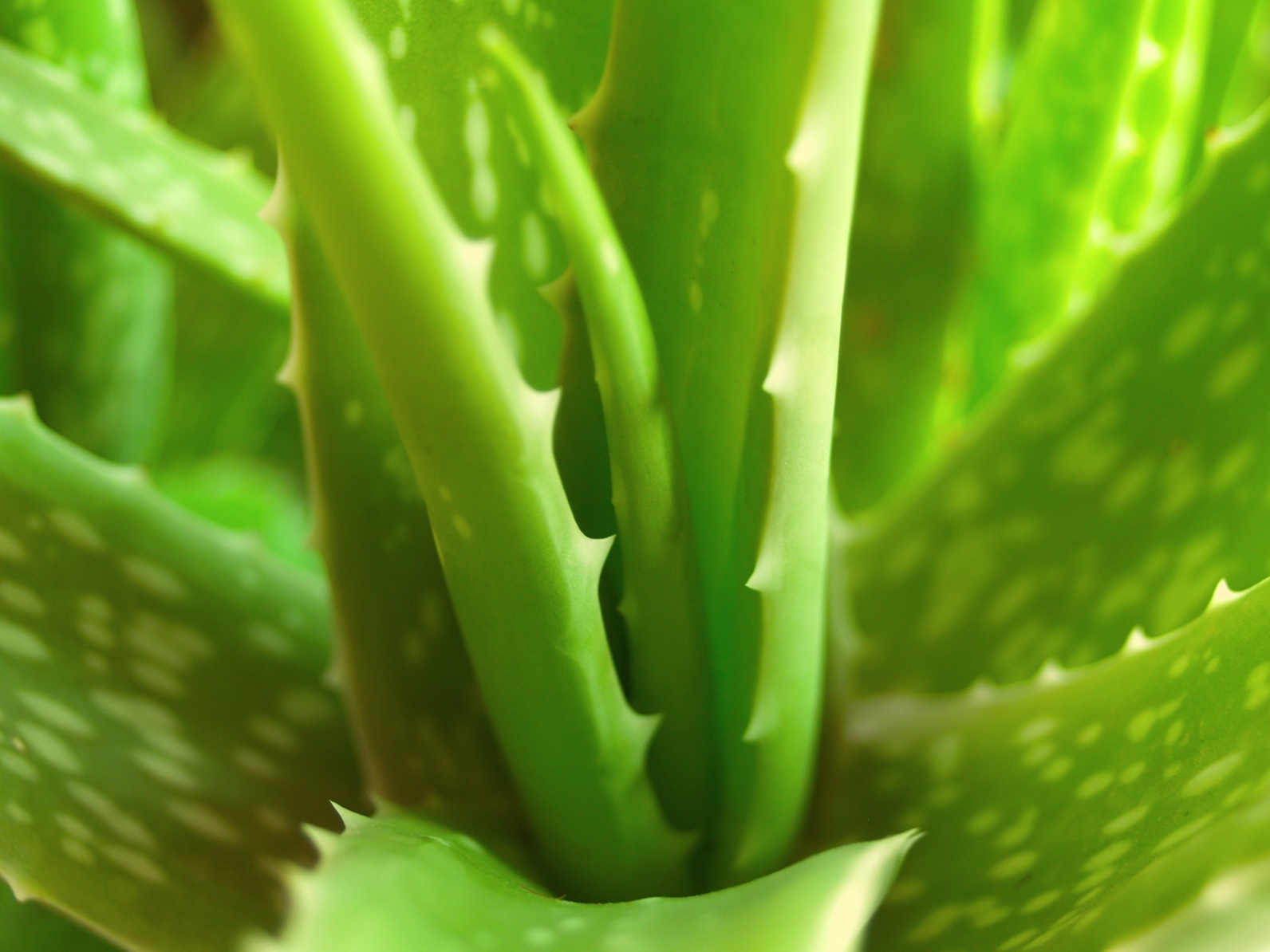Aloe vera (L)
Synonyms: Aloe barbadensis (Mill.), Curacao aloes, Barbados aloes, first-aid plant, medicine plant
Order: Liliaceae
Description: A large succulent perennial plant growing up to 1.5 metres in height, with a strong fibrous root and a large stem supporting a rosette of narrow lanceolate leaves up to 60cm long. The leaves are whitish green on both sides and bear spiny teeth on the margins. The yellow to purplish drooping flowers grow in a long raceme at the top of the flower stalk. The fruit is a triangular capsule containing numerous seeds. It is native to East and South Africa and cultivated in the West Indies and other tropical areas.
Parts used: Aloes is the evaporated liquid exuded from the cut leaf bases. The fresh gel is also used for topical applications.
Collection: The bitter juice is obtained by mechanical or chemical means from the parenchyma tissue in the centre of the leaf, and the liquid evaporated.
Constituents: Aloes: Hydroxyanthracene derivatives of the anthrone type (principally barbaloin); 7-hydroxyaloin isomers, aloe-emodin, chrysophanol and their glycosides; chromone derivatives (aloesin and its derivatives aloeresins A and C, and the aglycone aloesone. Gel: glucomannan (a polysaccharide), steroids, organic acids, enzymes, antibiotic principles, amino acids, saponins, minerals.
Actions: Aloes: Stimulating laxative, purgative, cathartic, choleretic, emmenagogue, uterine stimulant, abortifacient, anthelmintic. Gel: soothing and healing to damaged tissues
Indications: Constipation. Topically for wounds and burns
Therapeutics and Pharmacology: Aloes is taken internally as a purgative, acting on the lower bowel. It may be used in atonic constipation although overdosage can result in diarrhoea, gastritis and nephritis. To avoid griping, it should be taken in conjunction with carminative and antispasmodic herbs. It is the 1,8-dihydroxyanthracene derivatives such as barbaloin which have a laxative effect. As glycosides They are not absorbed in the upper gut but break down to the active aglycone in the colon and rectum. Laxatives containing anthranoids induce active secretion of water and electrolytes into the lumen of the gut and inhibit the absorption of electrolytes and water by the colon. The increased volume of contents of the colon activates peristalsis.
In the past, Aloes was used as an emmenagogue, small doses increasing menstrual flow. Aloe-emodin is reported to have anti-cancer activity in vitro. Aloes turns the urine red. The gel is used topically to aid wound healing and to relieve burns including sunburn; it encourages skin regeneration. It is also used for colonic irrigation.
Combinations: Take in conjunction with antispasmodics or carminatives to counteract griping. Metal salts are often used to enhance its action (e.g. iron pills).
Caution: Overdosage can cause gastritis, diarrhoea and nephritis. As Aloes stimulates uterine contractions, it should be avoided during pregnancy. Also, because it is excreted in breast milk, it should be avoided during lactation as it may be purgative to the child. It should also be avoided in kidney disorders, haemorrhoids or irritable bowel conditions. Aloes should be taken for a maximum of 8-10 days.
Preparation and Dosage:
Regulatory Status: GSL Schedule 1. Maximum dose 100mg; short-term use only
Aloes: 50-200mg, single dose at bedtime
Concentrated Compound Aloes Decoction B.P.C (1949): 4-15ml
Aloes Extract B.P.C 1949): 60-250mg
Aloes Tincture B.P.C (1949): 1:40 in 45% alcohol, 2-8ml
Additional Comments: The Aloe originates from tropical Africa, where related species are used as an antidote to poison arrow wounds. The Greeks and Romans used the gel for wounds. Aloes was a favoured purgative during the Middle Ages. It is used as a flavouring ingredient in low concentrations and aloe vera gel is an ingredient of many cosmetic preparations and sun creams. It is used as a paint to discourage nail biting due to its intensely bitter taste. Other species are also used medicinally; these include Aloe ferox (Mill.) or Cape Aloes, and Aloe perryi (Baker) or Socotrine or Zanzibar Aloes. Cultivated varieties are grown mainly for their reduced anthraquinone content.
Bibliography
Bradley, P.R. (ed.) 1992 British Herbal Compendium, Volume 1, BHMA, Bournemouth.
Grieve, M. 1931 A Modern Herbal, (ed. C.F. Leyel 1985), London.
Hoffmann, D. 1990 The New Holistic Herbal, Second Edition, Element, Shaftesbury.
Lust, J. 1990 The Herb Book, Bantam, London.
Mabey, R. (ed.) 1991 The Complete New Herbal, Penguin, London.
Mills, S.Y. 1993 The A-Z of Modern Herbalism, Diamond Books, London.
Ody, P. 1993 The Herb Society's Complete Medicinal Herbal, Dorling Kindersley, London.
Weiss, R.F. 1991 Herbal Medicine, Beaconsfield Arcanum, Beaconsfield.
Wren, R.C. 1988 Potter's New Cyclopaedia of Botanical Drugs and Preparations, C.W.Daniel, Saffron Walden.











